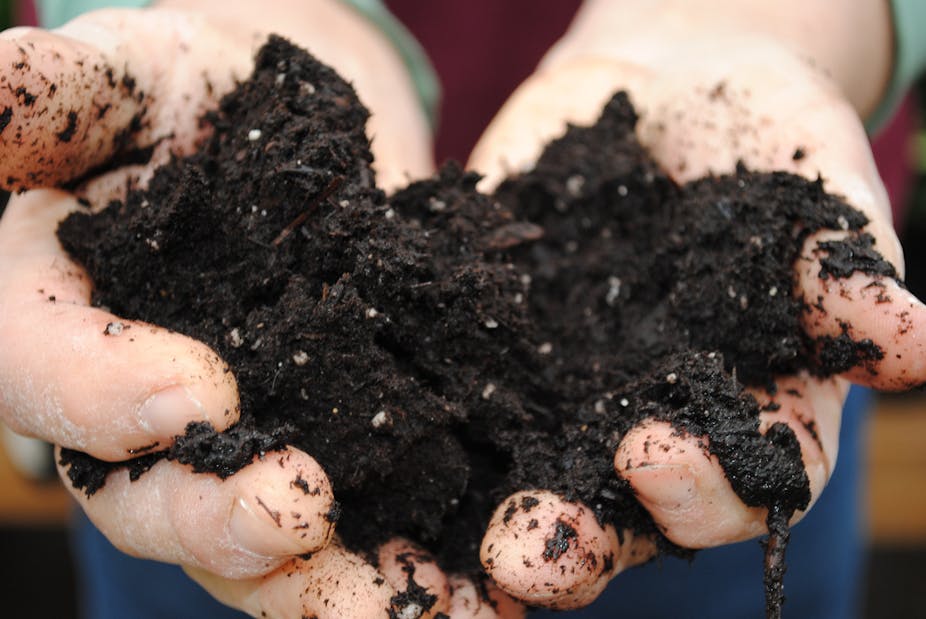**A more sustainable Australia* As the 2013 election campaign continues, we’ve asked academics to look at some of the long-term issues affecting Australia – the issues that will shape our future.*
Our soils are in trouble. Not only are they declining in health, but we’re losing the capacity to even know what state they’re in. Storing carbon may be one way to improve our soils, but it could also be a red herring.
We shouldn’t underestimate the problem. The UN predicts that the world’s population will exceed nine billion by 2050, requiring an increase in food production of 60%. And Australia’s continuing capacity as a major food producer and exporter relies on the sustainable management of our soil resources.
While conversations about environmental issues such as water resources, water quality, climate change and biodiversity have been brought to the forefront at some stage, our land resources seem to have slipped under the radar.
If we’re to build a sustainable future, we need to look to the dirt beneath our feet.
Sick soils
The first national audit of Australian soils, in 2000, found they were declining in health due to processes such as erosion, acidification, and salinisation. Thirteen years on and those problems have not improved.
The second phase of the audit, completed in 2008, found that our soils need long term monitoring, consistent information, and baseline data. The processes that affect soil health operate over large time scales and areas. It’s important to know where we started from and how to tell if things have changed.
Soil health is:
The continued capacity of soil to function as a vital living system, within ecosystem and land-use boundaries, to sustain biological productivity, maintain the quality of air and water environments and promote plant, animal and human health.
We’re also losing good, productive soils suitable for agriculture. When Australia’s major cities were first settled, they were located on fertile land for food production and close to reliable water supplies. But as the cities expanded these productive soils were developed. This has consequences for food production, particularly in the urban fringe of a number of Australian cities, including Sydney and Melbourne.
Resource and geography expert Dr Nicole Cooke at University of Melbourne says there is currently no coherent food policy in planning scheme and instruments, and the current productivity of peri-urban environments is more by accident than design. Some pioneering municipalities, such as Bacchus Marsh just west of Melbourne, are endeavouring to embed landscape productivity into their planning schemes.
Is carbon storage the future?
The recent Sustainable Australia Report also identifies that soil carbon stocks are low across agricultural regions but are central to maintaining soil health and food production.
Both the government and coalition have carbon policies that include managing soils to increase carbon storage. Recent research suggests that these solutions are technically and economically unsound.
Increasing soil carbon is unlikely to offset Australia’s carbon emissions. But that’s not to say we shouldn’t look at it for other reasons. Managing soils for carbon can part of the way to improving soil health.
Increasing soil carbon is largely reliant on increasing the amount of soil organic matter. This can be done through a number of means, including retaining or increasing ground cover, reducing tillage, and increasing plant growth.
Where soil organic matter is increased, additional benefits such as decreased erosion, improved nutrient cycling and soil fertility, and increased buffering capacity, and hence, resilience, can result.
Give soils a chance
There are still a number of gaps in our understanding the link between soil organic matter, soil health and sustainability.
Understanding the role of soil biology currently lags behind current knowledge on other disciplines of soil science. This knowledge is critical in improving soil health as nutrient cycling, decomposition and a range of other important soil processes are reliant on soil life.
Exciting soil molecular biological research into the underlying biology of the nitrogen cycle is revolutionising our thinking about how and what soil organisms form nitrate, known as nitrification. Manipulating nitrification will be a key to improving nitrogen use efficiency in agriculture, and lessening the environmental impacts of food production.
But knowledge of the importance of soils and soil science is gradually declining in the natural resource management area. The gradual contraction and demise of the former state soil conservation surveys or their equivalent has resulted in the loss of a generation’s worth of soils knowledge. The surveys provided much needed broad-scale information at the time for agriculture. This now needs to be updated and improved to a scale that is useful for land managers. There is some work to nationally coordinate soil surveys through ASRIS, however this has been under-resourced and progress has been slow.
Government agencies are decreasing their involvement in soils research and communication of soils-related knowledge to landholders and the community. These roles are increasingly being replaced by consultants who answer a specific problem or are hired for a specific task. This results in a piecemeal approach, and the bigger picture gets lost amongst these smaller projects.
Thanks to the Sustainable Australia Report 2013 for inspiring this series.

